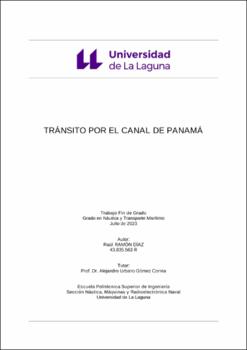Tránsito por el Canal de Panamá
Autor
Ramón Díaz, RaúlFecha
2023Resumen
En estos tiempos de rápida evolución tecnológica, el Canal de Panamá, con su historia
centenaria, sigue siendo una de las obras más fascinantes creadas por el ser humano.
Desafiando a la naturaleza, logró establecer una ruta eficiente que continúa siendo relevante
en la actualidad.
Navegar por las aguas del Canal y presenciar todo el proceso involucrado en su
travesía es una experiencia que todo marino, incluyéndome, debería vivir al menos una vez
en la vida. Es el único canal en el mundo donde el práctico asume total control y
responsabilidad de la embarcación, realizando maniobras precisas y sin margen de error. Con
la ayuda de remolcadores y locomotoras, cada movimiento requiere máxima atención para
evitar posibles accidentes, lo que convierte esta profesión en algo realmente atractivo.
El objetivo principal de este trabajo es resaltar la magnitud de cruzar el Canal de
Panamá y mostrar las ventajas que ha brindado tanto al país como al mercado mundial desde
su creación. El canal se ha convertido en una pieza clave en la industria naviera y ha
impulsado el comercio internacional de manera significativa.
Al ofrecer una ruta más corta y eficiente entre los océanos Atlántico y Pacífico, el Canal
de Panamá ha reducido los tiempos y costos de transporte para las empresas, generando un
impacto positivo en el comercio global. Además, la creación del canal ha impulsado el
desarrollo económico en Panamá, proporcionando fuentes de ingresos a través de los peajes
y fomentando el crecimiento del turismo y la industria marítima en la región.
El Canal de Panamá sigue siendo un logro impresionante y emblemático en la historia
de la ingeniería. Su trascendencia en el comercio mundial y en la economía de Panamá es
innegable. A medida que la tecnología y el comercio continúan avanzando, el Canal de
Panamá se mantendrá como una arteria vital para el transporte marítimo global en los años
venideros. In these times of rapid technological evolution, the Panama Canal, with its century-old
history, remains one of the most fascinating feats ever created by mankind. Defying nature, it
established an efficient route that continues to be relevant today.
Sailing through the waters of the Canal and witnessing the entire process involved in
its crossing is an experience that every mariner, including myself, should have at least once in
a lifetime. It is the only canal in the world where the pilot assumes complete control and
responsibility of the vessel, executing precise maneuvers without room for error. With the
assistance of tugboats and locomotives, every movement requires utmost attention to avoid
potential accidents, making this profession truly enticing.
The main objective of this work is to highlight the magnitude of crossing the Panama
Canal and showcase the advantages it has brought to both the country and the global market
since its inception. The canal has become a key player in the shipping industry and has
significantly boosted international trade.
By offering a shorter and more efficient route between the Atlantic and Pacific Oceans,
the Panama Canal has reduced transportation times and costs for companies, generating a
positive impact on global commerce. Furthermore, the creation of the canal has spurred
economic development in Panama, providing income through tolls and fostering the growth of
tourism and the maritime industry in the region.
The Panama Canal remains an impressive and emblematic achievement in the history
of engineering. Its significance in global trade and Panama's economy is undeniable. As
technology and commerce continue to advance, the Panama Canal will remain a vital artery
for global maritime transportation in the years to come.




